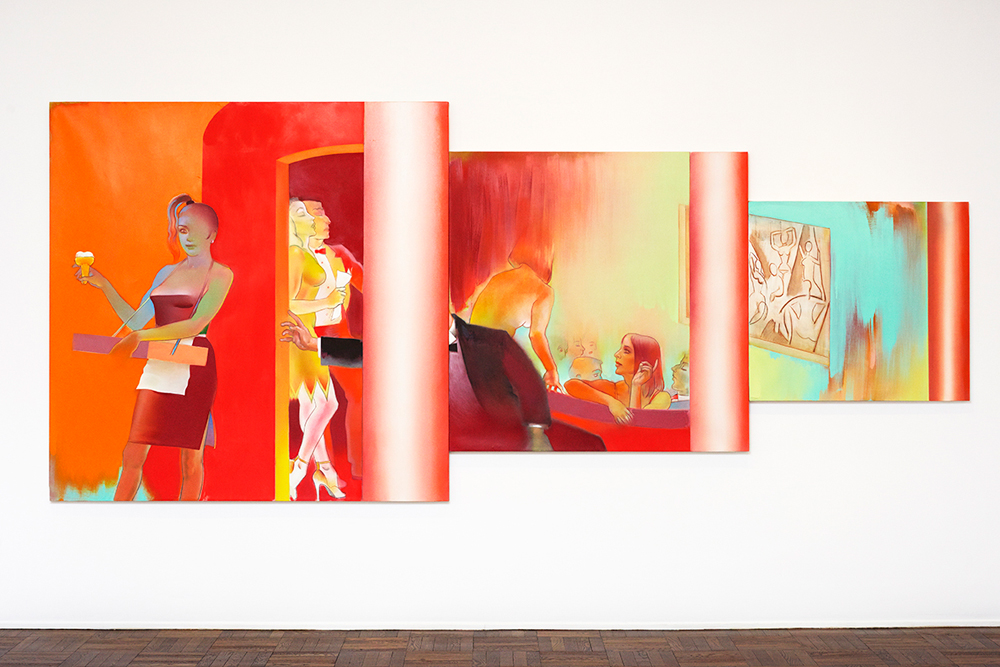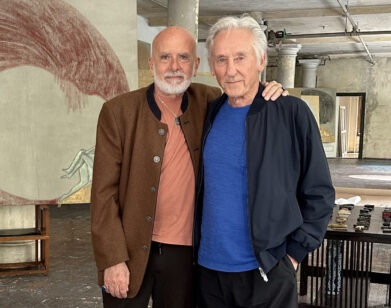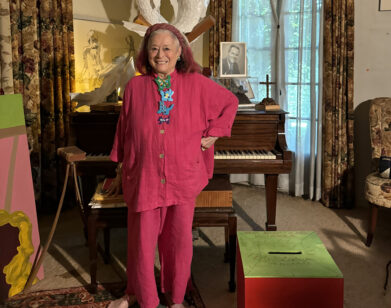Allen Jones Returns to New York
ALLEN JONES IN NEW YORK, APRIL 2016. PHOTOS: CHRISTIAN HOGSTEDT.
For the first time in nearly 30 years, famed and controversial British artist Allen Jones is exhibiting in New York City. The show, a concise retrospective at Michael Werner that spans six decades and includes only 15 pieces of work, reintroduces Jones to the city, setting the precedent for an exhibition of new artwork, tentatively scheduled for the fall/winter season. “Allen Jones: A Retrospective,” curated by Sir Normal Rosenthal, comprises two- and three-dimensional pieces, including Artisan I (1988), one of the artist’s first freestanding steel sculptures and Kate in Red (2013), a fantastical portrait of Kate Moss. The final room showcases six works, all depicting a type of performance: In Voila (2002), a woman floats, suspended in air above a magician’s stage; in Ovation (2010), a woman stands on stage in front of a crowd, her scanty underwear and backside plainly exposed; and in the triptych Interval (2007), a voyeuristic perspective sheds light onto guests—some of whom are nude—seated in a box at the opera. Featuring all types of female figures, the exhibition subtly reflects the controversy constantly surrounding Jones: does his work just objectify women, or is about evoking that discourse?
In 1970, Jones solidified his position at the center of this discussion with the debut of his notoriously submissive women-as-furniture series, Hatstand, Table, and Chair. The women appeared like mannequins straight out of a sex shop, posed to host men’s hats, drinks, and physical bodies. Then, when given the opportunity to design the 1973 Pirelli calendar, Jones’ women donned nothing other than black leather thigh-high boots and elbow-length gloves, and in 1975, he was asked to design the poster for Maîtresse, a film that provoked serious controversy in the U.K. and U.S. for its overt themes of sado-masochism.
Despite coming of age in the wake of Abstract Expressionism, Jones retained his use of the female figure and has now become one of the most recognized British pop artists. In the early ’60s, the London native took residency in New York’s Chelsea Hotel, just after the departure of Larry Rivers and shortly before it became home to the likes of Patti Smith and Robert Mapplethorpe. It was in New York that he grew into his own and began creating the work for which he is now known, and with “Allen Jones: A Retrospective,” he has finally returned.
We met Jones, now 78, at Michael Werner just before the opening of his retrospective, which coincides with an exhibition in London of a series inspired by his poster for Maîtresse. We embraced his surprising levity and amiable personality, while speaking about older works as well as American gas stations and Interview‘s December/January cover photo shoot, which was largely inspired by by Hatstand, Table, and Chair.
EMILY MCDERMOTT: Were any of these works made during your time living in New York?
ALLEN JONES: Three works were done at the Chelsea Hotel, [Curious Woman, Male Female Diptych, and Third Man]. Richard Feigen, who was then a Chicago art dealer and was just setting up in New York, saw my first show in London and said, “You want a show?” With the arrogance of youth, I thought, “It might be some funny little gallery around the back somewhere that doesn’t mean anything,” so I thought I’d better come to New York and have a look before committing myself. I visited in ’64 and it turned out to be a good deal, so I got a green card and came. The Chelsea Hotel didn’t have the reputation that it has now. It was pre-Warhol’s Chelsea Girls, by about a year. I was using a room that had been the studio of Larry Rivers, and Claes Oldenburg’s wife Patty was still there. The French artist Arman was also working there. It was a great place.
MCDERMOTT: Did you find yourself immediately enmeshed within the community?
JONES: A museum director in the U.K. introduced me to the Motherwells, so that was my introduction. I was 25, something like that, and suddenly found myself having drinks in a room full of abstract expressionists. Everyone from Rothko to—Barnett Newman wasn’t there, but I met him a little later. I quickly got to know [Roy] Lichtenstein and Tom Wessellman. Those became the mainstays.
MCDERMOTT: Do you remember what first struck you about their work, even before meeting them?
JONES: I’d seen a Lichtenstein, but there was nothing like the media existence now. There were no color supplements, certainly not in Europe. If someone came back with a photograph, it was like looking at some precious object. An art dealer I showed with in London was the first person to show American pop art in the U.K. and one of them was a Liechtenstein diptych of a waste bin called Step On Can With Leg [1961]. I saw this picture and it was like a license, a release. I thought, “That can be art? I should be fearless!” [laughs]
Also, although New York’s a great melting pot and people come and go from all over the world, I found a generosity amongst the artists, a generosity of spirit, and was invited to their studios in a way in which I wouldn’t have interacted with people back home. So I had access to terrific work across the spectrum. I like to see artist’s work that is on the other side of the planet from me. If you see stuff related to what you do, it doesn’t surprise me that I like it. But to go down to Barnett Newman or [James] Rosenquist’s studio was just fantastic. But of course America was on such a bigger scale. The actual unit of life is bigger—the rooms were bigger, the spaces, and so on. All of that was very exciting.
MCDERMOTT: It’s funny you say that because when you hear New York, you don’t necessarily think of things as being bigger. You usually think of New York as being cramped.
JONES: Well it’s conditioning, isn’t it? In London, particularly then, the unit is much smaller—the houses, the rooms, somehow it’s just not as spacious. As I drove around America I couldn’t get over how casually they distributed gas stations. You’d see this gas station with acres of ground around it. It just seems like such a casual use of space.
MCDERMOTT: Can you tell me about Curious Woman [1964-65]? It’s much more collage-like than your other works.
JONES: Times Square was a revelation in those days. It most likely still is to people coming here, but it’s rather sanitized now. Sixth Avenue was a line of very honky tonk buildings, most either called Wig City or dealing in adult joke material or pornography. I saw these falsies for sale in a box, which said, “Makes every gal or guy bigger and better!” I thought it would be great to have the figure [of the work] come into your space, but the trouble was that the falsies were made of very thin plastic. I was going to fill them with resin, which would hold the bolts [to the canvas], but when you put a catalyst with the resin it generates a lot of heat. It melted the breasts. I had to go back three times in a week, buy three pairs in a week. It was in the depths of winter and I realized the solution: Outside the studio window was a gully and it was full of snow, so I stuffed the falsies in there and left them for half an hour. Then, when I poured the resin in, it worked. I saw this picture a year ago because I had a big show at the Royal Academy, but I hadn’t seen it for nearly 40 years.
MCDERMOTT: What did you think when you saw it again? Had its significance changed?
JONES: It’s like an old friend, really. And it looks funkier than what I do now. When I look back on the work, I can see when I’m trying to ram ideas through some sort of grill of what I thought fine art should be, so it would come out looking like serious art. By staying in New York, the one thing I learned is that you have to get rid of all that and do whatever you want to do, as directly and clearly as possible, and you have to take the consequences of your work.
MCDERMOTT: Was there anything in particular that helped you begin embracing your work and disregarding what other people thought?
JONES: It was an act of maturity. You know, the penny dropped, and I’m sure it drops for some people earlier than others. An acquaintance of mine is Frank Stella. I saw the show a few months ago at the Whitney and I know the work very well, but I was staggered by the dates on those pictures. He’s just a year older than me, but for some reason I thought he was an older guy doing those pictures; I looked at the dates and he was precociously mature. The penny drops at different speeds.
MCDERMOTT: I want to talk about the sculpture Man About Town [1986-2013]. I read something about a folded piece of paper inspiring its form?
JONES: I was painting figures so volumetrically, it seemed to be a good idea to try and make them. I thought, “What happens if you cut the figure out of the picture?” Obviously it wouldn’t have any structure, it’s paper, but if you put an arbitrary fold it, then it has structure. That proved to be a very interesting vein because I’ve been making steel sculptures consistently since the mid-’80s. Because it is two-dimensional, in the act of folding it, the story unwinds, so you have to walk around the figure to get the whole story. It seems childishly obvious but it’s a pleasure to play with that idea.
MCDERMOTT: Was the image of Kate Moss painted before or after you met her?
JONES: I didn’t know her. It was a German collector who’s obsessed with her. Chuck Close had done something for him, a whole range of artists, and I suppose my name came up. So she came to the studio a few times and sat for me. I drew her and photographed her, but I suddenly realized that she’s visiting my world, rather than me visiting her’s, so I put her in this sculpture that I’d never previously exhibited. I sawed the arms and the head off a Hatstand sculpture and made it body armor. Two sculptures and about three paintings came out of it. This [Kate in Red, 2013] is the one I got to keep.
MCDERMOTT: You don’t frequently paint portraits, so who else has actually visited your studio and sat for you?
JONES: I don’t like painting portraits because by and large they’re for wealthy men who want me to paint their wife’s head on the shoulders of some idealized figure. [laughs] I’m uncomfortable with that. Fortunately I didn’t have to do it, but there have been a couple of requests: Kate was one and the other was with Darcy Bussell, who was a ballerina at the Royal Ballet. The National Portrait Gallery asked if I could paint her. I did two paintings of her, but for me it’s like drawing teeth, it’s a very difficult thing.
Once before, I painted a woman in the ’70s and that was a very strange request. It was a white guy who lived in Nigeria and had some business in flax—something like six percent of the national gross income was [from] his company—and he was obsessed with the Revlon girl, the face of Revlon. He had photographers take photographs of her at every angle. Peter Beard knew this man and said “You’re paying [Richard] Avedon all this money to take photographs. You could actually have art, you know.” So Warhol worked with her and Larry Rivers. Then it was my turn and I said, “Does she come to London?” and he said “No, but we have thousands of photographs.” I said, “That’s helpful but I have to see the person,” and he said, “Well if you must,” and sent me a ticket [to New York]. I used Larry River’s studio and drew her there and photographed her facing sideways, getting down on one knee, just moving. But basically the responsibility is too much. I don’t like doing it.
MCDERMOTT: You’re also having the “Maîtresse” show in London right now, which is composed of work you never indented to exhibit.
JONES: The “Maîtresse” paintings were done for personal pleasure over the years, but suddenly there was this body of work and they were quite unlike my main stream of painting. In the ’70s I was invited to do the poster for the film Maîtresse. It’s now an art house movie, but they couldn’t get general release in the U.K. because it was considered too heavy duty. So when they asked me, I didn’t know what it was about. They said, “If you fly to Paris, you can see it in one of those viewing theaters,” and so I sat on my own in this little viewing theater. There was some very heavy stuff going on. It scared the pants off me. Then a man came in the darkness, sat next to me, and said “Monsieur Jones” and took out this envelope bulging with money. I was paid in cash right then.
So I did the poster for the American distribution and I never sold the painting because I thought, “It was conceived as a poster so maybe it’s not Art, with a capital A.” It is different if you’re painting a subject to illustrate it, but it enabled me; there was a pleasure of painting textual material. So I decided to do a series of paintings about what it would be like if you were behind the curtain, or what happens if she knocks over the letters, or if she picks up the letters, or if she sits down?
MCDERMOTT: So I also brought you a copy of our December/January issue, because the cover photo shoot was largely inspired by your work.
JONES: [flips through the pages and Kylie Jenner story] This is fantastic! I have a drawer full [of] variations on the furniture sculpture idea. I have a fantasy that Taschen would do a book and we would have a whole sequence showing the incredible range of the use of this image from all over the world, including from the London underground and some artist in China who does panoramic paintings. [Once,] Dasha Zhukova was sitting on [the New York-based Norwegian artist] Bjarne Melgaard’s version of my chair—this tall, wealthy white Russian sitting on a black version of my work, on International Woman’s day! [laughs] I came home one day and there were a lot of messages on my phone, all from the press wanting to get in touch about this thing, including the BBC news. I have a place in the country and the gardener even rang and said, “I don’t know what’s happening, there are all these photographers…” This is out in the middle of Oxfordshire—if people want to find you, they certainly can. In the end, I went on the BBC, they said, “What do you think about the thing?” and I said, “Listen this is a beautiful, wealthy young woman, she has just bought this sculpture, the photographer comes in, it’s a chair, and says ‘Hey sit down.’ It’s not meant to be an insult to half of the globe,” but such is the power of the image and the press… But this is incredible. I love magazines. I’ve heard about this person [Kylie Jenner] and her family. The business of transgender, that’s the flavor of the moment isn’t it? I find that life, as we go on, seems to be an affirmation of my paintings.
“ALLEN JONES: A RETROSPECTIVE” WILL BE ON VIEW AT MICHAEL WERNER GALLERY, NEW YORK THROUGH JUNE 4, 2016.







